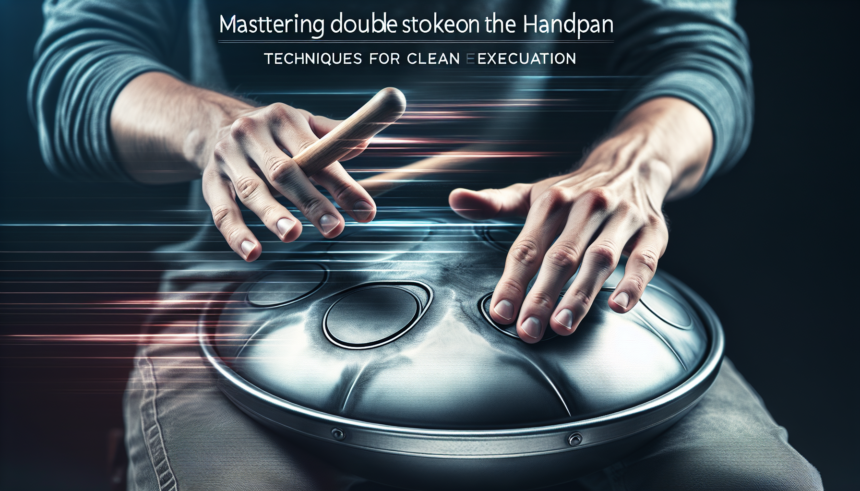The handpan, an ethereal and melodious instrument, has captivated the hearts of musicians and listeners alike. Its unique sound and playing method require a distinct set of skills. Among these is the execution of double strokes, which are crucial for achieving fluidity and speed in your playing. In this article, we will delve into the techniques necessary to master double strokes on the handpan, ensuring clean and efficient execution.
Understanding Double Strokes
Double strokes involve striking the handpan twice with the same hand in quick succession. This technique can add complexity and dynamics to your playing, allowing for faster rhythms and intricate patterns. The ultimate goal is to produce even, clear, and controlled hits, making the strokes indistinguishable in terms of volume and tone.
Proper Hand Positioning
Before diving into double strokes, it’s essential to establish the correct hand positioning:
- Relaxation: Keep your hands relaxed. Tension can hinder speed and control.
- Finger Placement: Position your fingers gently on the surface of the handpan. Avoid rigid or stiff placements.
- Strike Point: Aim for the center of each note’s dome for optimal sound quality and resonance.
Practicing proper hand positioning will prevent injuries and ensure more consistent and pleasing tones.
Developing Muscle Memory
Muscle memory plays a pivotal role in mastering double strokes. Here are a few steps to build this crucial skill:
Slow Practice
Start slow. Ensure each stroke is delivered accurately and consistently. Gradually increase speed while maintaining precision. This step-by-step approach solidifies proper technique into muscle memory.
Consistent Repetition
Consistent and deliberate practice is key. Repeating the same motion helps engrain the movement, enabling your hands to perform double strokes effortlessly over time.
Metronome Utilization
Using a metronome can significantly aid in honing your double stroke technique. Begin with a slow tempo, focusing on even and clean strokes. Gradually increase the speed as your proficiency improves. This method promotes synchronization and timing.
Hand Independence and Coordination
Developing hand independence and coordination is crucial for effective double strokes. Here are a few exercises to enhance these skills:
Alternating Hands
Practice alternating strokes between your right and left hands. This helps in developing balanced coordination and ensures both hands are equally skilled.
Pattern Practice
Incorporate various patterns and rhythms into your practice routines. Try different combinations of double strokes within these patterns to challenge and improve your coordination.
Mirror Exercise
Using a mirror can provide visual feedback. Watch your hands as you practice to ensure symmetry and consistency between both. This can help identify and correct any discrepancies in your technique.
Finger and Wrist Techniques
The roles of your fingers and wrists are critical in executing clean double strokes. Let’s explore effective techniques for both.
Utilizing Fingers
Use your fingers to initiate the stroke, ensuring a light touch. The tips of your fingers should make contact with the surface of the handpan. This allows for greater control and finesse.
Engaging the Wrist
Complement your finger movements with subtle wrist action. This combined effort from both fingers and wrist ensures smooth and precise strokes, reducing the strain on either part.
Finger Drills
Practice finger drills, such as playing simple scales or arpeggios with double strokes. This helps in developing finger strength and dexterity, contributing to cleaner execution of double strokes.
Dynamic Control
Mastering double strokes isn’t just about speed and precision; dynamic control plays a significant role in the quality of your performance.
Volume Variation
Practice playing double strokes at varying volumes. This trains your ability to control the intensity and ensures that both strokes are balanced in terms of loudness.
Soft and Hard Strokes
Integrate both soft and hard strokes into your practice. This not only builds control but also adds expressive quality to your playing. Aim for evenness in tone, regardless of the dynamic level.
Incorporating Double Strokes into Music
Once you are confident with double strokes, it’s time to incorporate them into your playing:
Simple Patterns
Start by integrating double strokes into simple rhythmic patterns. Gradually increase complexity as you become more comfortable.
Complex Compositions
Challenge yourself by incorporating double strokes into more complex compositions or improvisations. This practice enhances your adaptability and enriches your musical expression.
Creative Expression
Explore different musical genres and styles. Experimenting with various contexts helps in discovering new applications of double strokes, ultimately broadening your musical vocabulary.
Conclusion
Mastering double strokes on the handpan is a rewarding journey that requires patience, disciplined practice, and a keen ear for detail. By focusing on proper hand positioning, developing muscle memory, enhancing hand independence, and perfecting finger and wrist techniques, you can achieve clean and expressive double strokes. Incorporating these techniques into your musical repertoire will undoubtedly elevate your handpan performance, allowing for greater fluidity, speed, and creativity.
FAQs
1. How long does it take to master double strokes on the handpan?
The time it takes to master double strokes varies for each individual, depending on factors such as prior experience, practice consistency, and natural aptitude. With regular and focused practice, significant progress can be made within a few months.
2. Can I practice double strokes without a handpan?
While having a handpan is ideal, practicing finger and wrist exercises on a flat surface or using practice pads can still be beneficial. This can help develop the necessary muscle memory and coordination needed for double strokes.
3. What should I do if I experience pain while practicing double strokes?
If you experience pain while practicing, it’s crucial to evaluate your technique and ensure you are not applying excessive force or tension. Taking breaks, stretching, and relaxing your hands can help prevent strain. Persistence in correct technique will improve comfort over time.
4. How can I incorporate double strokes into my musical compositions?
Start by integrating double strokes into simple rhythms and gradually progress to more complex patterns. Use your ear to find spots where double strokes can add interest and dynamic quality to your music. Experiment in different musical contexts to find what works best for you.
5. Do I need a teacher to learn double strokes effectively?
While having a teacher can provide valuable guidance and feedback, it is not absolutely necessary. There are numerous online resources, tutorials, and communities dedicated to handpan playing that can support your learning journey. Self-discipline and regular practice are the keys to progress.





